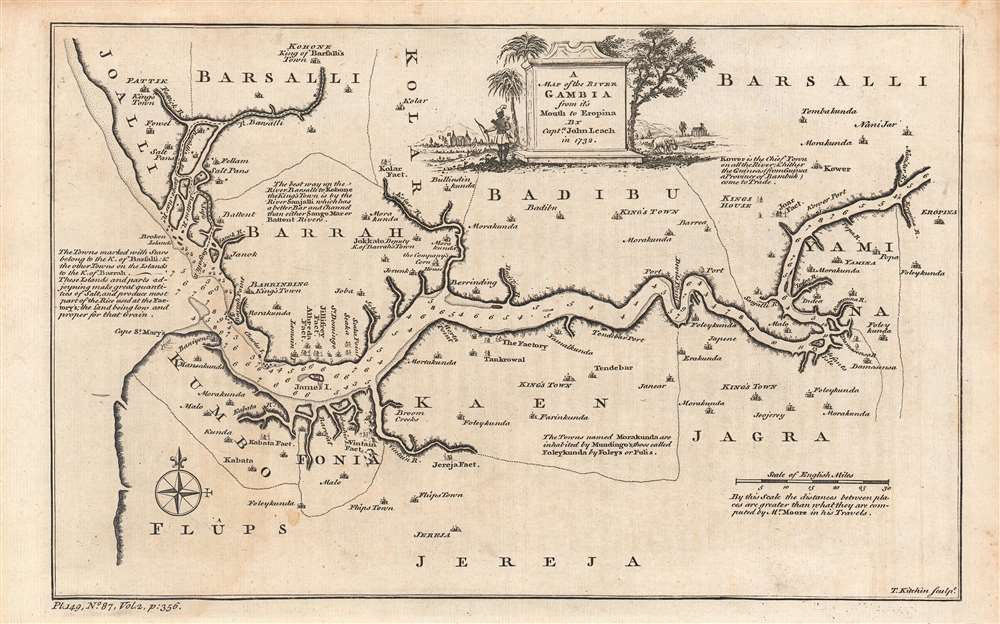This item has been sold, but you can get on the Waitlist to be notified if another example becomes available, or purchase a digital scan.
1752 Leach / Kitchin Map of the Gambia River, West Africa
GambiaRiver-kitchin-1752
Title
1752 (undated) 8 x 13 in (20.32 x 33.02 cm) 1 : 900000
Description
A Closer Look
Coverage extends from the Atlantic coast and along the Gambia River to Eropina, roughly half-way into the territory of the contemporary nation-state of The Gambia, which is oriented around the river. The travels of John Leach, an agent of the Royal African Company, inform the map. Leach and Thomas Harrison explored the area in 1732 in search of new trading opportunities. The Royal African Company was a chartered monopoly created to manage English trade along the west coast of Africa, but it was supplanted in the early 18th century, leading to a free-for-all among private traders, contributing to an increase in the scale and brutality of the slave trade.Trading posts ('factories'), forts (such as the British fort on James Island), ports, and other facilities utilized by British traders and their agents (such as 'the company's corn house') line the river. Many indigenous settlements are indicated, some of which roughly correspond to their present-day name (for example, 'Morakunda' now as Marong Kunda, and 'Kower,' noted at right as 'the chief town on all the river,' is today rendered as Kauur). Due to his extended foray in the region, Leach is also especially well informed about local political constellations, aligning around the rulers of Barsalli and Barrah.
On the water, soundings, hazards, shallow waters, are indicated and throughout Kitchin includes explanatory notes from Leach on the peoples and settlements around the river. A decorative cartouche with a vignette crowns the map at top.
Publication History and Census
This map was engraved by Thomas Kitchin based on descriptions by John Leach of his travels in the region. Its provenance is somewhat unclear; maps based on Leach's travels first appeared in Francis Moore's Travels into the inland parts of Africa (1738), but they differ widely from Kitchin's work (Moore's work is referred to below the scale, confirming that this map was produced afterwards). The present map was included in A New General Collection of Voyages and Travels, published between 1745 and 1747, but its notation in that work is entirely different ('Pl. XLI, Vol. 2, page 159') and located at bottom-right, below Kitchin's name. It was reproduced in French by Nicholas Bellin for l'Abbé Prevost’s Histoire generale des voyages.This edition of the map with the present notation ('Pl. 149, No. 87, Vol. 2, p. 356') is held by Stanford University, Princeton University, and the University of Cambridge, all of which date it to 1732, too early given that Kitchin was born in 1718. Research by Barbara Backus McCorkle suggests that this edition of the map appeared in Thomas Salmon's The universal traveller: or, a compleat description of the several foreign nations of the world, published in 1752 - 1753. A close examination of the margin just outside of the neatline at bottom-right shows a previous notation stricken out from the plate that appears to match that in A New General Collection of Voyages and Travels, suggesting that the present map postdates that work, which would also correspond with Salmon's book as the likeliest source.
Cartographer
Thomas Kitchin (August 4, 1718 – June 23, 1784) was a London based engraver, cartographer, and publisher. He was born in London to a hat-dyer of the same name. At 14, Kitchin apprenticed under Emanuel Bowen, under whom he mastered the art of engraving. He married Bowen daughter, Sarah Bowen, and later inherited much of his preceptor's prosperous business. Their son, Thomas Bowen Kitchin, also an engraver joined the family business, which thereafter published in Thomas Kitchin and Son. From 1858 or so Kitchin was the engraver to the Duke of York, and from about 1773 acquired the title, 'Royal Hydrographer to King George III.' He is responsible for numerous maps published in the The Star, Gentleman's Magazine, and London Magazine, as well as partnering with, at various times, with Thomas Jefferys, Emmanuel Bowen, Thomas Hinton, Issac Tayor, Andrew Dury, John Rocque, Louis de la Rochette, and Alexander Hogg, among others. Kitchin passed his business on to his son, Thomas Bowen Kitchin, who continued to republish many of his maps well after his death. Kitchin's apprentices included George Rollos, Bryant Lodge, Thomas Bowen Kitchin, Samuel Turner Sparrow, John Page, and Francis Vivares. More by this mapmaker...

